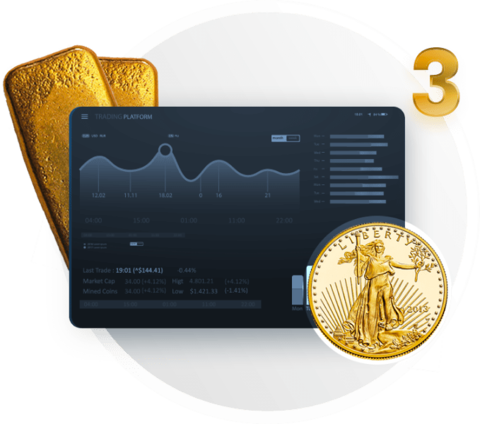Trading the Gold to Silver Ratio: Savvy Investment Strategy in December 2025?

Looking to enhance your investing strategy of precious metals? A technique centered around the key indicator of the gold/silver ratio may provide the insight you want.
Featured Partner Offer

Hard Assets Alliance
on Hard Asset Alliance’s site
Limited-Time Offer: Invest and earn up to $1,500. Open any storage account with Hard Assets Alliance (excluding IRAs) and purchase your choice of precious metals to earn up to $1,500. Terms Apply.
Investors and traders commonly look at gold as a hedge in times of uncertainty, but many investors keep tabs on the prices of precious metals closely even in less volatile times. That’s because of interest in the gold/silver ratio, the relationship between the price between gold and silver. It’s one of the most tracked exchange rates in history — dating back to even ancient times.
Why is that, though? To grasp the importance of the gold/silver ratio you have to understand exactly what it is and its history. Dive in with our detailed guide.
What is the Gold/Silver Ratio?
The gold/silver ratio, also known as the mint ratio, tells you the quantity of silver ounces needed to purchase one ounce of gold. Calculate the gold/silver ratio by taking: gold price per ounce divided by silver price per ounce.
The measurement of the gold/silver ratio provides context to investors and traders who would like to know the valuation of these two precious metals in relation to each other.
How does the Gold/Silver Ratio Work?
The gold/silver ratio works by acting as a measurement of how much silver is needed to purchase gold. It acts as a tool for decision making and understanding current value.
To understand how the gold/silver ratio works, it helps to consider a practical example. Let’s say you have one ounce of gold and the ratio rises to 100. That means that during this period you can sell your one ounce of gold for a hundred ounces of silver. In this scenario, imagine the ratio then drops to a low of 50. Your one hundred ounces of silver can now be sold for two ounces of gold. With a focus on accumulating precious metal for long-term investment, you’ve now doubled your initial gold from one ounce to two ounces while staying invested in precious metals during the precious.
How do Investors Use the Gold/Silver Ratio?
Investors can trade the gold/silver ratio through a savvy investment strategy, placing short-term actions based on the direction of gold in relation to silver. This is because gold is more sensitive to market uncertainty and demand in a way silver is usually not.
Assuming one owns gold as it drives up towards an unusually high figure, one can trade their gold and move that value into silver. Then, as the ratio drops to lower amounts, the trader might decide to sell their silver and buy a higher amount of gold than they originally had prior to deploying this strategy. This strategy essentially allows traders to take advantage of fluctuations in the gold/silver ratio.
Buying Precious Metals
There’s a number of platforms that make it easy to get started and to keep investing thereafter. These can help cure the frustration that many would expect with buying precious metals online. Hard Assets Alliance is a trusted platform that allows you to fund, buy, sell and manage your holdings all in the same platform. Providing tangible, physical precious metals directly to customers, investments are 100% real with total transparency. It’s perfect for those looking to get started and diversify their holdings.

Gold/Silver Ratio Charts
You can use gold/silver charts as a source to help identify long-term and short-term trends in the relationship between gold and silver. The data can help you dive into whether gold or silver are undervalued or overvalued at current prices., helping you decide if it’s the right time to invest in gold or silver.
Greek, Roman and Byzantine civilizations used the gold/silver ratio even during ancient times. The ratio typically sat between 10 and 13.5 during the time of the first coins in Greece while it was set at 12 during the Roman Empire.
Moving over to modern times, the gold/silver ratio has historically ranged from 15 to over 100 with a typical range between 40 to 70.
Gold/Silver Ratio Last Ten Years
Looking at the last ten years, dating July of 2015 to July of 2025, the gold/silver ratio has seen lows of around 60 while hitting a high of 125 in 2025. Traders who were able to take advantage of volatile times during 2020 and 2021 may have benefited from correct timing with their precious metal rotations.

Gold/Silver Ratio versus VIX
Both the VIX and the gold/silver ratio are used to understand current market sentiment. The VIX, also known as the CBOE Volatility Index, is a popular measure of the volatility expected in the stock market based on S&P 500 index options. While the VIX and the gold/silver ratio both measure sentiment, they tend to behave differently. The VIX sees more short-lived, dramatic movements, while the gold/silver ratio tends to see more leveling off after a spike.
Tips when Using the Gold/Silver Ratio
After getting a firm understanding of the gold/silver ratio, here are some tips to keep in mind.
Past Performance of Gold and Silver Provides No Guarantee of Future Results
Historical trends of the gold/silver ratio are just that — historical. They may provide context on what the future could hold but there are important factors in the present that may lead to different outcomes. Use history as a basis rather than a predictor. You may sell your gold for silver, thinking the ratio has topped out, then see new highs in the gold/silver ratio.
Pick the Way that’s Best For You
Each way to trade the gold/silver ratio has its own risk and rewards associated with it. There are futures contracts, ETFs and options. There’s also physical gold but that comes with the added cost of having to store it. There are powerful online marketplaces, like Hard Assets Alliance, that allow you to buy precious metals online, allowing you to store whole bars and coins in secure non-bank vaults. You can add to your holding, sell some or take delivery whenever you would like all online in a matter of seconds.
The Bottom Line: Timing Your Moves with Confidence
For decades, savvy investors have used the gold/silver ratio to guide their decisions on when to shift between gold and silver to accumulate more metal over time. By tracking this ratio and understanding its trends, you may be able to position yourself to make smarter moves, whether you’re looking to grow your holdings or preserve long-term purchasing power.
Platforms like Hard Assets Alliance can help you act with confidence when opportunity knocks. With tools like historical charts, real-time pricing, and flexible investing options — including secure vault storage and tax-advantaged accounts — knowledge can help empower action with confidence.
💰Sponsored Content. This post was written in partnership with Hard Assets Alliance.
Frequently Asked Questions
What’s the all-time high for the gold/silver ratio?
The all-time high for the gold/silver ratio is more than 125, which occurred in April of 2020 during the initial uncertainty of the COVID-19 pandemic. This meant that during this time it would have taken 125 ounces of silver to equal one ounce of gold.
What do you buy when the gold/silver ratio is high?
When the gold/silver ratio is high, it may mean that silver is a bargain in comparison to gold. It could be an ideal time to sell gold in exchange for the purchase of silver. A low gold/silver ratio may mean that gold is the better value and that you would want to accumulate more gold.
What is the 80-50 rule for gold/silver ratio?
The 80-50 rule for the gold/silver ratio is the popular approach of switching into silver once the ratio hits around 80 and back into gold once it hits 50, profiting from the swing in this range. This method may apply every few years, depending on volatility.
How much of my net worth should be in gold or silver?
There’s a common recommendation to have 5 to 15 percent of your portfolio in gold and other precious metals. This can typically range depending on your investing goals and tolerance.
Dave Ramsey is someone that views gold as a bad investment since it does not provide regular income like stocks or bonds, relying on price fluctuations. However, there’s a number of influential gold investors that view gold as a timeless asset. This includes Ray Dalio of Bridgewater Associates.
Can you trade the gold-silver ratio?
Yes, you can trade the gold-silver ratio to take advantage of the fluctuating relationship. Investors can leverage ETFs to capitalize on the gold/silver ratio. Futures and options can also provide exposure. Many still look to trade physical gold and silver that are purchased from reputable dealers and platforms since these are tangible assets.
